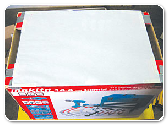How To: Make a Multi-touch Screen
There has been a lot of hype around the concept of multi-touch technology. It
started in 2006 when Jeff Han demonstrated his revolutionary multi-touch table
at a TED (Technology, Entertainment, Design) conference (
www.ted.com). The audience at the demonstration went absolutely nuts over what Jeff had to
show them.
Unlike conventional touch-screens, multi-touch gives the user the ability to use multiple fingers and strokes, for a variety of applications.
Unlike conventional touch-screens, multi-touch gives the user the ability to use multiple fingers and strokes, for a variety of applications.

But the real question everyone started asking was: “Ok, but what can we use it for?”. Microsoft and Apple answered the question, each developing different systems
to make use of the new technology. Microsoft came up with Microsoft Surface, a
multi-touch table, and Apple introduced multi-touch into the iPhone and, more
recently, the MacBook Pro.
It is amazing to see how far the technology has advanced in less than three
years. It was inevitable then that the open source community would start
producing software and hardware for multi-touch. So, from being awed by Jeff
’s table in 2006 to the pages of TechSmart, you can actually make a basic multi-touch screen for yourself. Seriously.
You’ll need:
• A piece of clear, flat sturdy material (glass, acrylic, plexiglass); a
cardboard box, about the same size as the glass or acrylic; paper (printer
paper, tracing paper, just about any paper will do); webcam and a PC.
• tbeta (http://tbeta.nuigroup.com/), the open source software that enables your multi-touch surface to work.
Making the table is pretty straight forward. First, using masking tape, attach
the paper to the plexiglass, ensuring that you leave as much white paper
showing as possible. Then make a hole in the side of the box for the webcam
’s cable to go through. Now tape the webcam down in the middle of the box, facing
directly upwards. Place the plexiglass, paper side down, onto the box. All that
is left is to unzip the tbeta folder and plug the webcam into your PC.
This multi-touch implementation works by recording an image of the shadows cast
onto the glass or acrylic, by your finger-tips, using the webcam, and
converting it into a signal that a multi-touch application can use. It is
important to note that you have to have a room with fairly even lighting,
otherwise your hands will cast longer shadows on the glass/ acrylic and the
software won
’t work properly. So there you go, your own multi-touch screen in under 30
minutes.


